Quick filters:
Boethius fortune Stock Photos and Images
 Coëtivy Master (Henri de Vulcop ) (French, active about 1450 - 1485) - Philosophy Consoling Boethius and Fortune Turning the Wheel - Google Art Project Stock Photohttps://www.alamy.com/image-license-details/?v=1https://www.alamy.com/cotivy-master-henri-de-vulcop-french-active-about-1450-1485-philosophy-consoling-boethius-and-fortune-turning-the-wheel-google-art-project-image184963939.html
Coëtivy Master (Henri de Vulcop ) (French, active about 1450 - 1485) - Philosophy Consoling Boethius and Fortune Turning the Wheel - Google Art Project Stock Photohttps://www.alamy.com/image-license-details/?v=1https://www.alamy.com/cotivy-master-henri-de-vulcop-french-active-about-1450-1485-philosophy-consoling-boethius-and-fortune-turning-the-wheel-google-art-project-image184963939.htmlRMMMWRAY–Coëtivy Master (Henri de Vulcop ) (French, active about 1450 - 1485) - Philosophy Consoling Boethius and Fortune Turning the Wheel - Google Art Project
 Philosophy Consoling Boethius and Fortune Turning the Wheel; Coëtivy Master, Henri de Vulcop?, French, active about 1450 - 1485 Stock Photohttps://www.alamy.com/image-license-details/?v=1https://www.alamy.com/philosophy-consoling-boethius-and-fortune-turning-the-wheel-cotivy-master-henri-de-vulcop-french-active-about-1450-1485-image220677579.html
Philosophy Consoling Boethius and Fortune Turning the Wheel; Coëtivy Master, Henri de Vulcop?, French, active about 1450 - 1485 Stock Photohttps://www.alamy.com/image-license-details/?v=1https://www.alamy.com/philosophy-consoling-boethius-and-fortune-turning-the-wheel-cotivy-master-henri-de-vulcop-french-active-about-1450-1485-image220677579.htmlRMPR0ME3–Philosophy Consoling Boethius and Fortune Turning the Wheel; Coëtivy Master, Henri de Vulcop?, French, active about 1450 - 1485
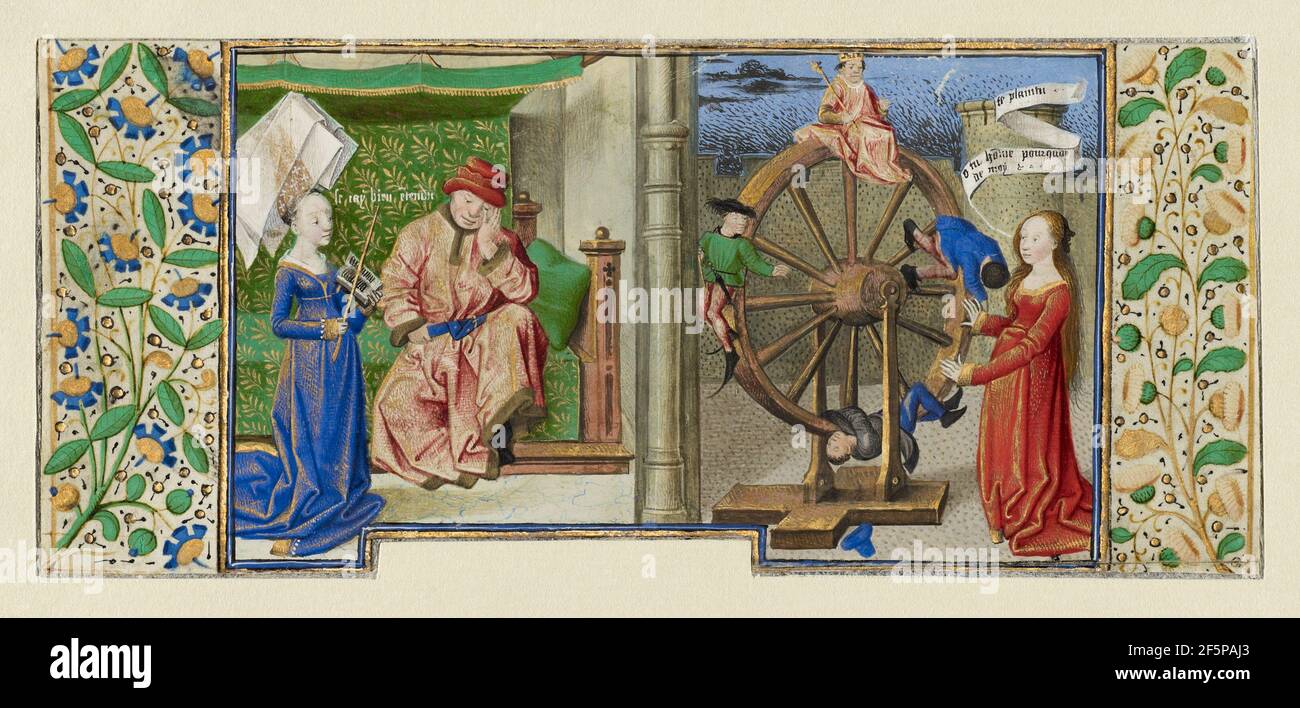 Philosophy Consoling Boethius and Fortune Turning the Wheel. Coëtivy Master (Henri de Vulcop?) (French, active about 1450 - 1485) Stock Photohttps://www.alamy.com/image-license-details/?v=1https://www.alamy.com/philosophy-consoling-boethius-and-fortune-turning-the-wheel-cotivy-master-henri-de-vulcop-french-active-about-1450-1485-image416613403.html
Philosophy Consoling Boethius and Fortune Turning the Wheel. Coëtivy Master (Henri de Vulcop?) (French, active about 1450 - 1485) Stock Photohttps://www.alamy.com/image-license-details/?v=1https://www.alamy.com/philosophy-consoling-boethius-and-fortune-turning-the-wheel-cotivy-master-henri-de-vulcop-french-active-about-1450-1485-image416613403.htmlRM2F5PAJ3–Philosophy Consoling Boethius and Fortune Turning the Wheel. Coëtivy Master (Henri de Vulcop?) (French, active about 1450 - 1485)
 Philosophy Consoling Boethius and Fortune Turning the Wheel; Coëtivy Master (Henri de Vulcop?), French Stock Photohttps://www.alamy.com/image-license-details/?v=1https://www.alamy.com/stock-photo-philosophy-consoling-boethius-and-fortune-turning-the-wheel-cotivy-77446664.html
Philosophy Consoling Boethius and Fortune Turning the Wheel; Coëtivy Master (Henri de Vulcop?), French Stock Photohttps://www.alamy.com/image-license-details/?v=1https://www.alamy.com/stock-photo-philosophy-consoling-boethius-and-fortune-turning-the-wheel-cotivy-77446664.htmlRMEE0008–Philosophy Consoling Boethius and Fortune Turning the Wheel; Coëtivy Master (Henri de Vulcop?), French
 Engraving depicting the Wheel of Fortune. Engraving after miniature in a 15th-century manuscript of Boethius. Stock Photohttps://www.alamy.com/image-license-details/?v=1https://www.alamy.com/engraving-depicting-the-wheel-of-fortune-engraving-after-miniature-in-a-15th-century-manuscript-of-boethius-image377041300.html
Engraving depicting the Wheel of Fortune. Engraving after miniature in a 15th-century manuscript of Boethius. Stock Photohttps://www.alamy.com/image-license-details/?v=1https://www.alamy.com/engraving-depicting-the-wheel-of-fortune-engraving-after-miniature-in-a-15th-century-manuscript-of-boethius-image377041300.htmlRM2CWBM0M–Engraving depicting the Wheel of Fortune. Engraving after miniature in a 15th-century manuscript of Boethius.
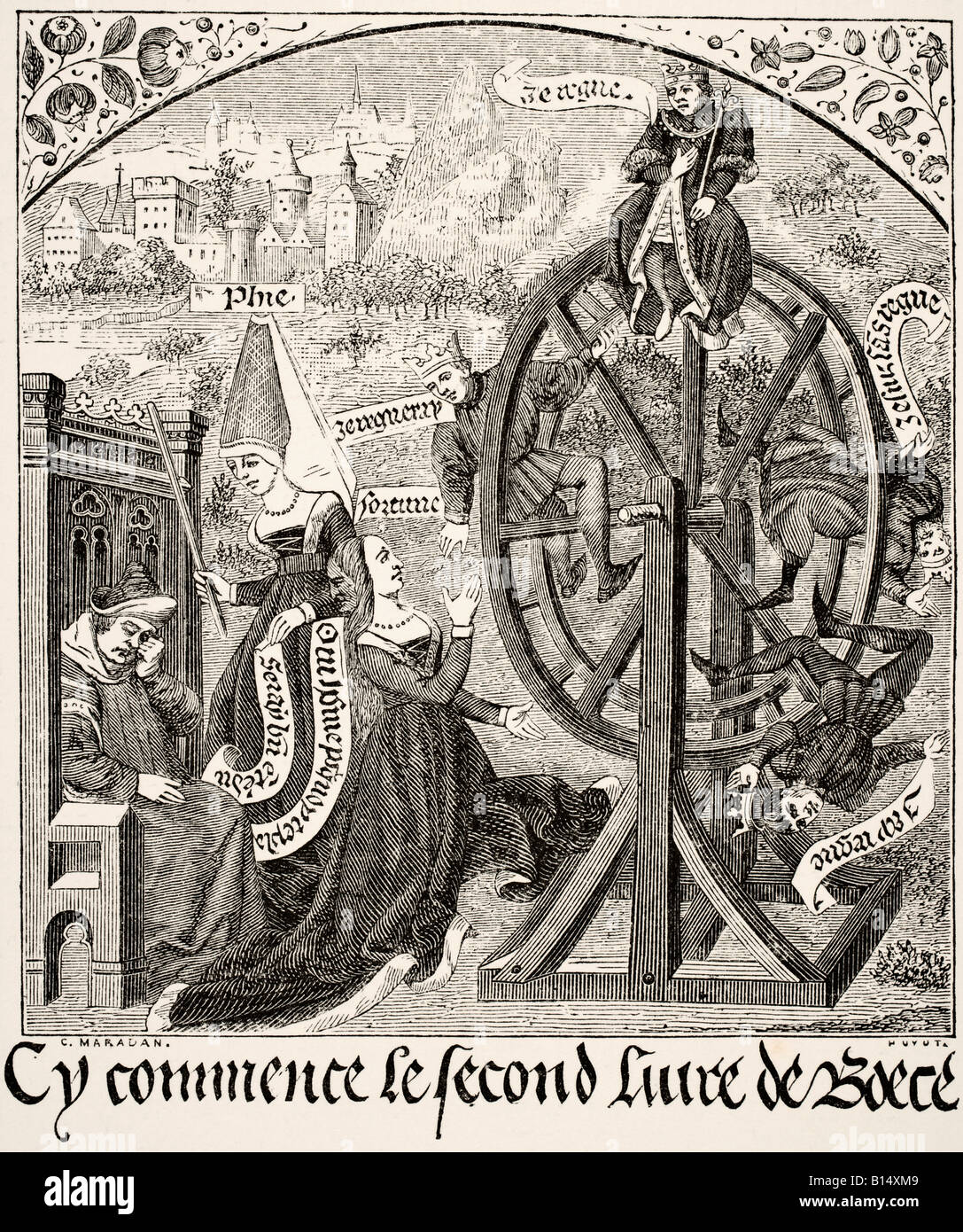 The Wheel of Fortune. After a miniature in the 15th century MS Consolation of Boethius. Stock Photohttps://www.alamy.com/image-license-details/?v=1https://www.alamy.com/stock-photo-the-wheel-of-fortune-after-a-miniature-in-the-15th-century-ms-consolation-17933785.html
The Wheel of Fortune. After a miniature in the 15th century MS Consolation of Boethius. Stock Photohttps://www.alamy.com/image-license-details/?v=1https://www.alamy.com/stock-photo-the-wheel-of-fortune-after-a-miniature-in-the-15th-century-ms-consolation-17933785.htmlRMB14XM9–The Wheel of Fortune. After a miniature in the 15th century MS Consolation of Boethius.
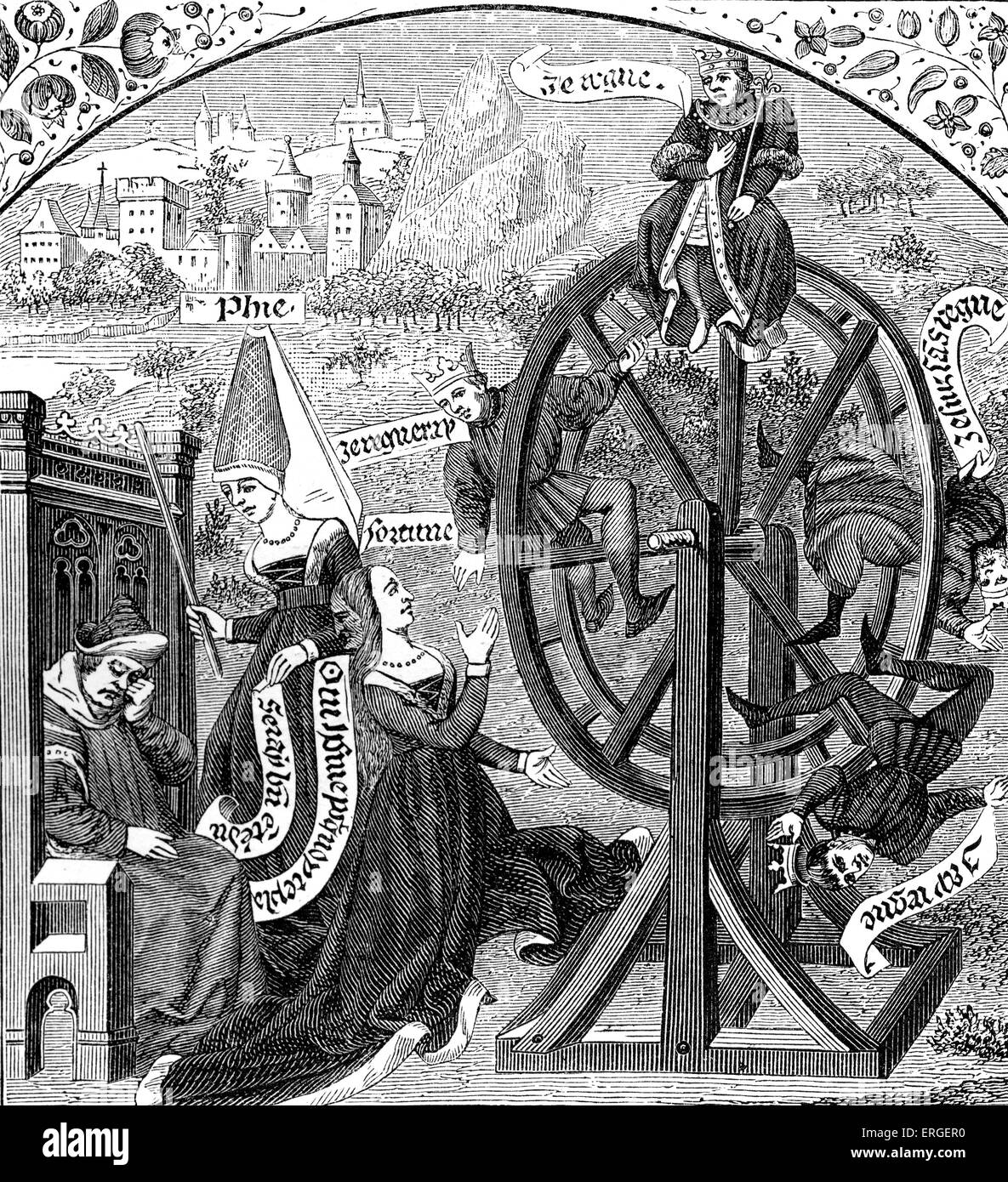 The Wheel of Fortune - from miniature of 'Consolation of Boethius', translated by Jean de Meung in 15th century manuscript Stock Photohttps://www.alamy.com/image-license-details/?v=1https://www.alamy.com/stock-photo-the-wheel-of-fortune-from-miniature-of-consolation-of-boethius-translated-83341412.html
The Wheel of Fortune - from miniature of 'Consolation of Boethius', translated by Jean de Meung in 15th century manuscript Stock Photohttps://www.alamy.com/image-license-details/?v=1https://www.alamy.com/stock-photo-the-wheel-of-fortune-from-miniature-of-consolation-of-boethius-translated-83341412.htmlRMERGER0–The Wheel of Fortune - from miniature of 'Consolation of Boethius', translated by Jean de Meung in 15th century manuscript
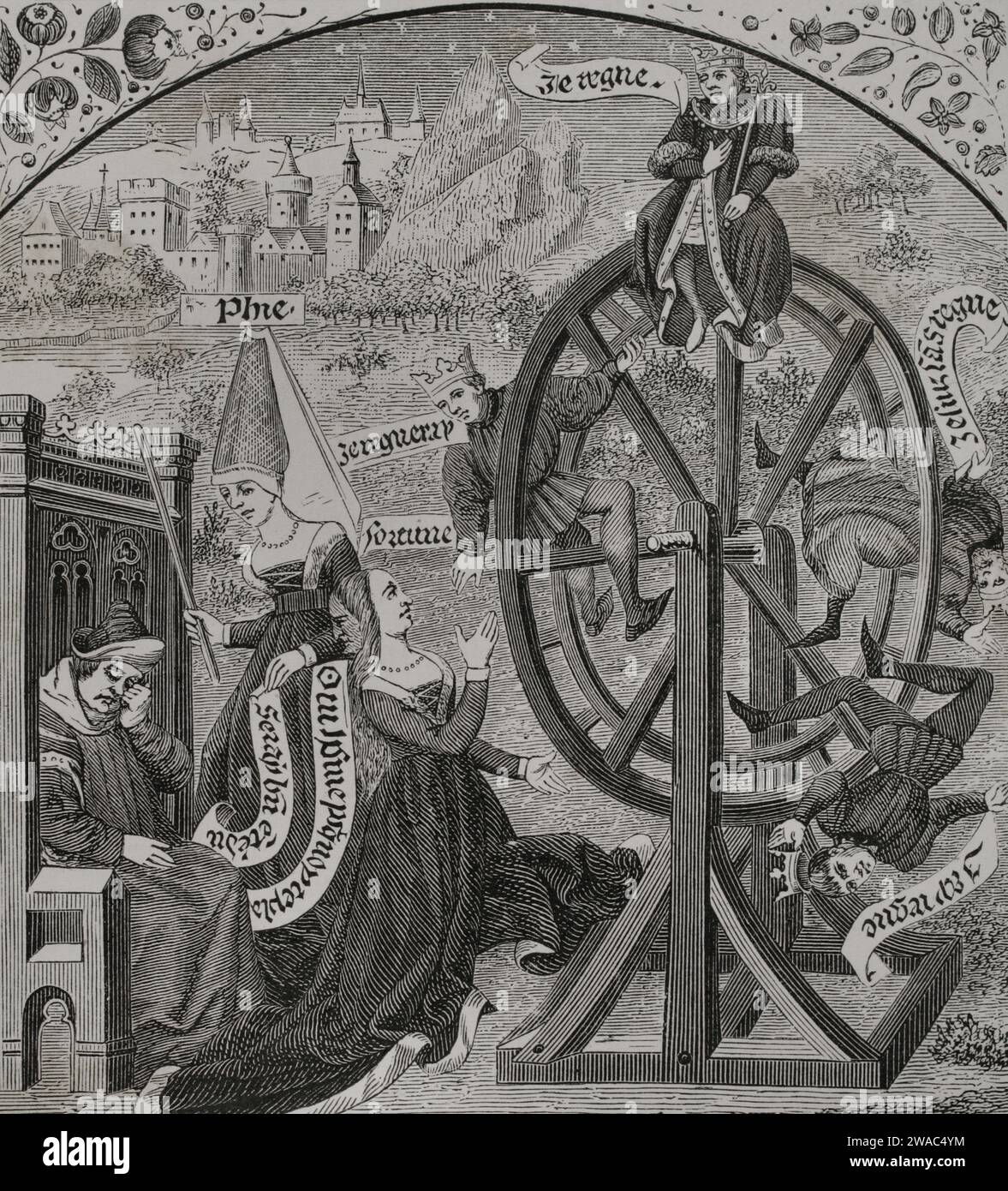 Wheel of Fortune. Engraving by Maradan after a miniature of Boethius 'Consolatio Philosophiae', published in the 16th century. Sciences & Lettres au Moyen Age et à l'époque de la Renaissance. Paris, 1877. Stock Photohttps://www.alamy.com/image-license-details/?v=1https://www.alamy.com/wheel-of-fortune-engraving-by-maradan-after-a-miniature-of-boethius-consolatio-philosophiae-published-in-the-16th-century-sciences-lettres-au-moyen-age-et-lpoque-de-la-renaissance-paris-1877-image591566408.html
Wheel of Fortune. Engraving by Maradan after a miniature of Boethius 'Consolatio Philosophiae', published in the 16th century. Sciences & Lettres au Moyen Age et à l'époque de la Renaissance. Paris, 1877. Stock Photohttps://www.alamy.com/image-license-details/?v=1https://www.alamy.com/wheel-of-fortune-engraving-by-maradan-after-a-miniature-of-boethius-consolatio-philosophiae-published-in-the-16th-century-sciences-lettres-au-moyen-age-et-lpoque-de-la-renaissance-paris-1877-image591566408.htmlRM2WAC4YM–Wheel of Fortune. Engraving by Maradan after a miniature of Boethius 'Consolatio Philosophiae', published in the 16th century. Sciences & Lettres au Moyen Age et à l'époque de la Renaissance. Paris, 1877.
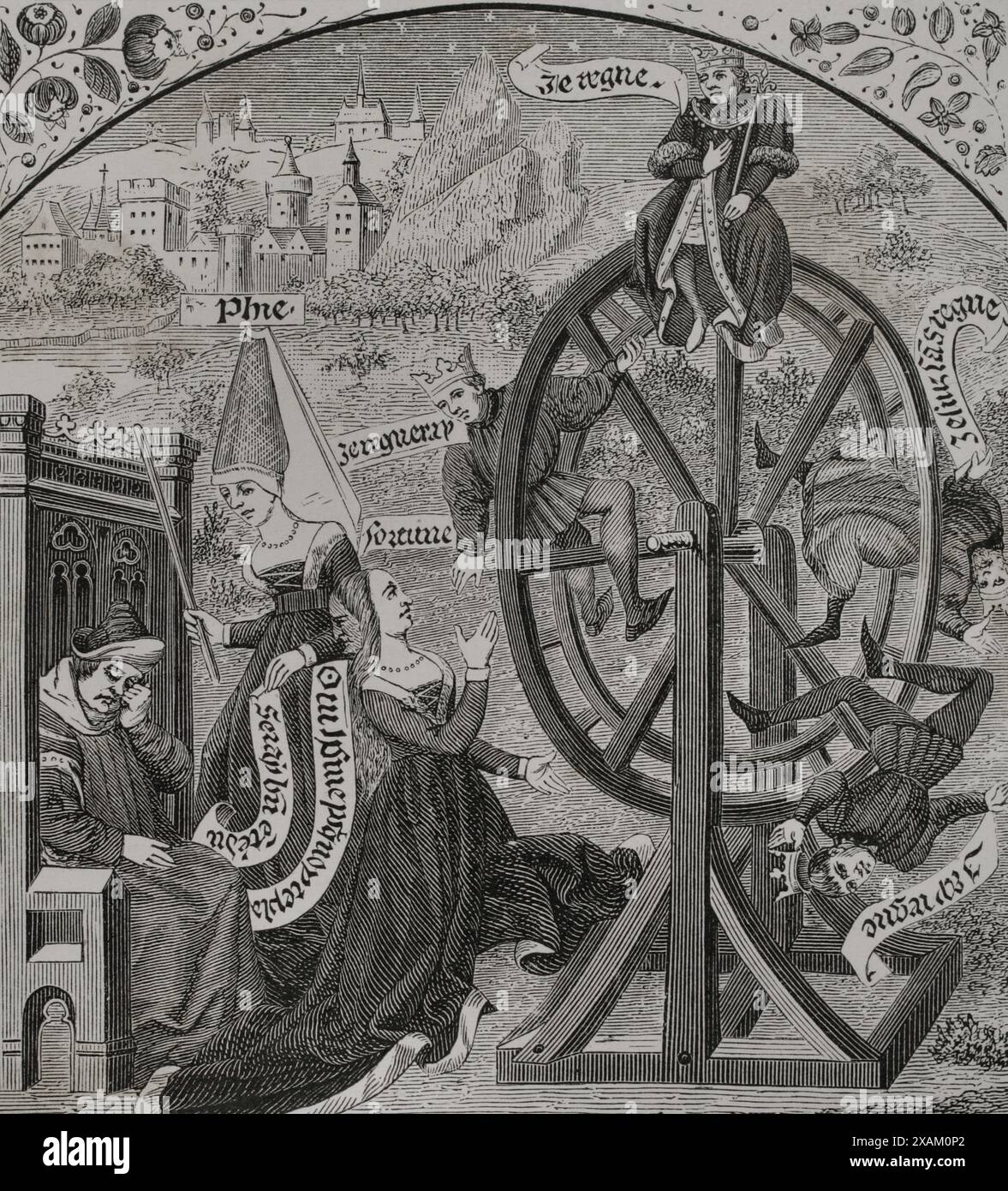 Wheel of Fortune. Engraving by Maradan after a miniature of Boethius 'Consolatio Philosophiae', published in the 16th century. Sciences & Lettres au Moyen Age et a l'epoque de la Renaissance. Paris, 1877. Stock Photohttps://www.alamy.com/image-license-details/?v=1https://www.alamy.com/wheel-of-fortune-engraving-by-maradan-after-a-miniature-of-boethius-consolatio-philosophiae-published-in-the-16th-century-sciences-lettres-au-moyen-age-et-a-lepoque-de-la-renaissance-paris-1877-image608949098.html
Wheel of Fortune. Engraving by Maradan after a miniature of Boethius 'Consolatio Philosophiae', published in the 16th century. Sciences & Lettres au Moyen Age et a l'epoque de la Renaissance. Paris, 1877. Stock Photohttps://www.alamy.com/image-license-details/?v=1https://www.alamy.com/wheel-of-fortune-engraving-by-maradan-after-a-miniature-of-boethius-consolatio-philosophiae-published-in-the-16th-century-sciences-lettres-au-moyen-age-et-a-lepoque-de-la-renaissance-paris-1877-image608949098.htmlRM2XAM0P2–Wheel of Fortune. Engraving by Maradan after a miniature of Boethius 'Consolatio Philosophiae', published in the 16th century. Sciences & Lettres au Moyen Age et a l'epoque de la Renaissance. Paris, 1877.
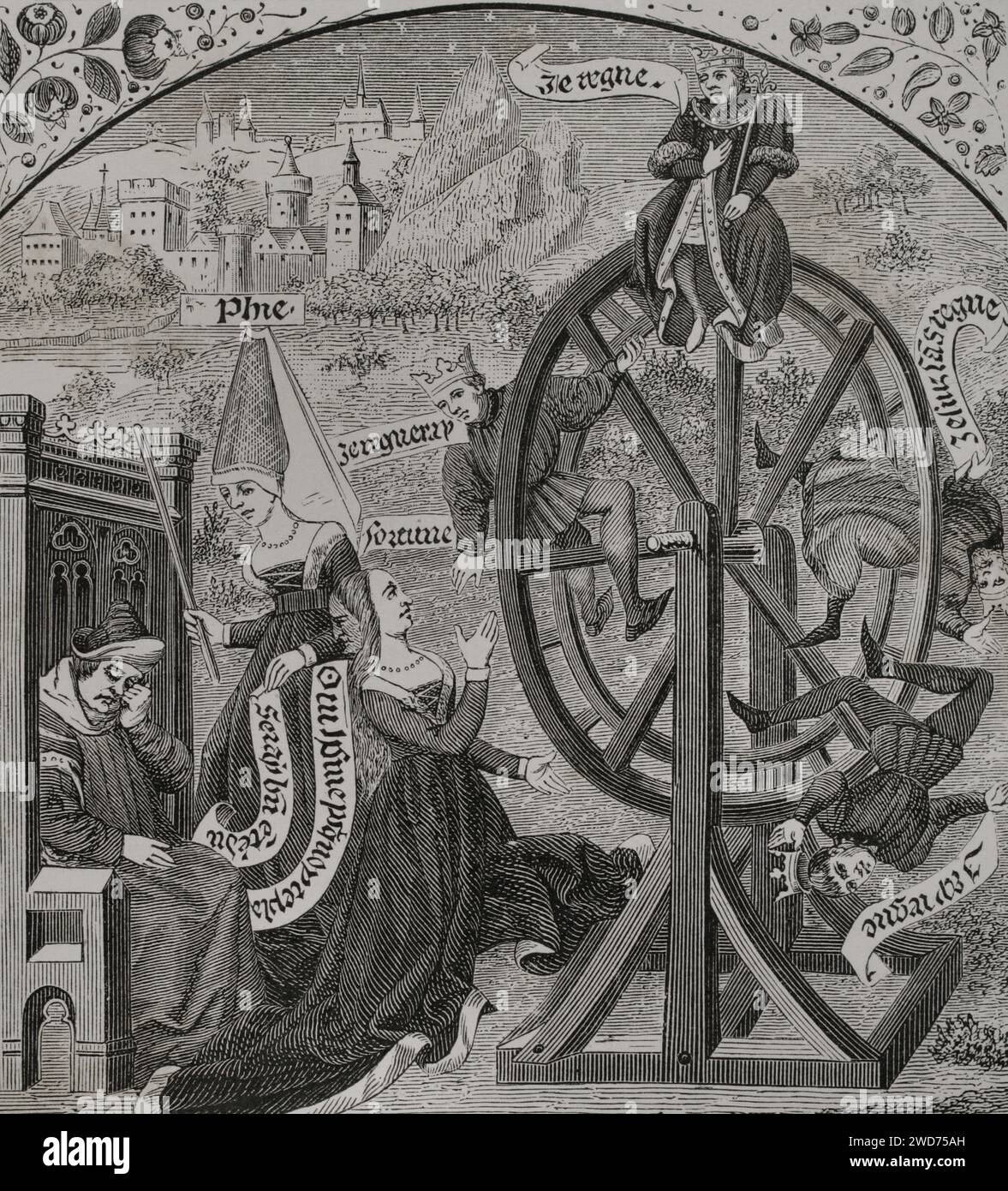 Wheel of Fortune. Engraving by Maradan after a miniature of Boethius 'Consolatio Philosophiae', published in the 16th century. Sciences & Lettres au Moyen Age et à l'époque de la Renaissance. Paris, 1877. Stock Photohttps://www.alamy.com/image-license-details/?v=1https://www.alamy.com/wheel-of-fortune-engraving-by-maradan-after-a-miniature-of-boethius-consolatio-philosophiae-published-in-the-16th-century-sciences-lettres-au-moyen-age-et-lpoque-de-la-renaissance-paris-1877-image593300921.html
Wheel of Fortune. Engraving by Maradan after a miniature of Boethius 'Consolatio Philosophiae', published in the 16th century. Sciences & Lettres au Moyen Age et à l'époque de la Renaissance. Paris, 1877. Stock Photohttps://www.alamy.com/image-license-details/?v=1https://www.alamy.com/wheel-of-fortune-engraving-by-maradan-after-a-miniature-of-boethius-consolatio-philosophiae-published-in-the-16th-century-sciences-lettres-au-moyen-age-et-lpoque-de-la-renaissance-paris-1877-image593300921.htmlRM2WD75AH–Wheel of Fortune. Engraving by Maradan after a miniature of Boethius 'Consolatio Philosophiae', published in the 16th century. Sciences & Lettres au Moyen Age et à l'époque de la Renaissance. Paris, 1877.
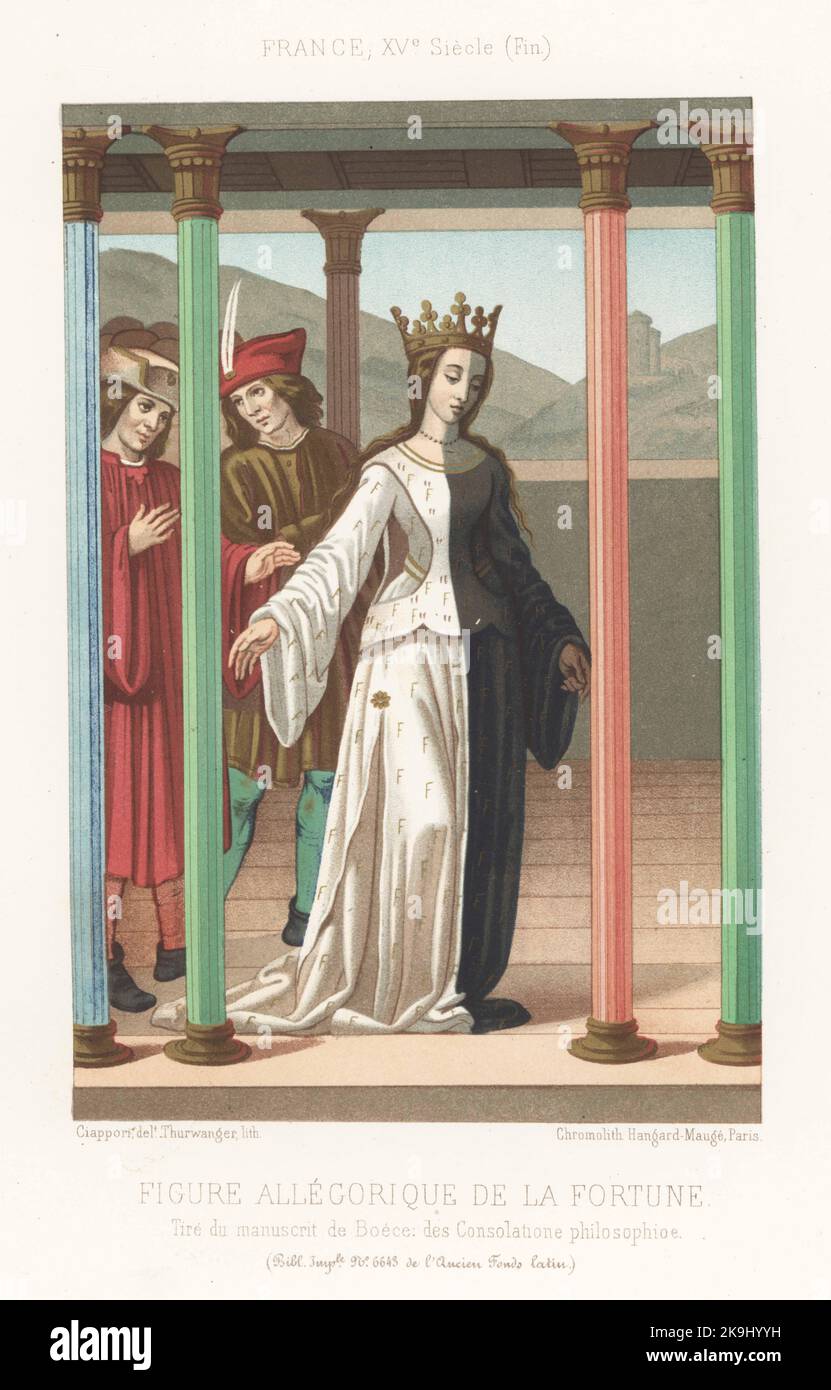 Fortune in crown walking in a colonnade, France, 15th century. In particolored robe, half white, half black, decorated with the letter F. France, end of the 15th century. Taken from a manuscript Boethius, De Consolatione philosophiae, MS 6643, Ancien Fonds Latin, Bibliotheque Imperiale. Figure allegorique de la Fortune. Chromolithograph by Thurwanger after an illustration by Claudius Joseph Ciappori from Charles Louandre’s Les Arts Somptuaires, The Sumptuary Arts, Hangard-Mauge, Paris, 1858. Stock Photohttps://www.alamy.com/image-license-details/?v=1https://www.alamy.com/fortune-in-crown-walking-in-a-colonnade-france-15th-century-in-particolored-robe-half-white-half-black-decorated-with-the-letter-f-france-end-of-the-15th-century-taken-from-a-manuscript-boethius-de-consolatione-philosophiae-ms-6643-ancien-fonds-latin-bibliotheque-imperiale-figure-allegorique-de-la-fortune-chromolithograph-by-thurwanger-after-an-illustration-by-claudius-joseph-ciappori-from-charles-louandres-les-arts-somptuaires-the-sumptuary-arts-hangard-mauge-paris-1858-image487817333.html
Fortune in crown walking in a colonnade, France, 15th century. In particolored robe, half white, half black, decorated with the letter F. France, end of the 15th century. Taken from a manuscript Boethius, De Consolatione philosophiae, MS 6643, Ancien Fonds Latin, Bibliotheque Imperiale. Figure allegorique de la Fortune. Chromolithograph by Thurwanger after an illustration by Claudius Joseph Ciappori from Charles Louandre’s Les Arts Somptuaires, The Sumptuary Arts, Hangard-Mauge, Paris, 1858. Stock Photohttps://www.alamy.com/image-license-details/?v=1https://www.alamy.com/fortune-in-crown-walking-in-a-colonnade-france-15th-century-in-particolored-robe-half-white-half-black-decorated-with-the-letter-f-france-end-of-the-15th-century-taken-from-a-manuscript-boethius-de-consolatione-philosophiae-ms-6643-ancien-fonds-latin-bibliotheque-imperiale-figure-allegorique-de-la-fortune-chromolithograph-by-thurwanger-after-an-illustration-by-claudius-joseph-ciappori-from-charles-louandres-les-arts-somptuaires-the-sumptuary-arts-hangard-mauge-paris-1858-image487817333.htmlRM2K9HYYH–Fortune in crown walking in a colonnade, France, 15th century. In particolored robe, half white, half black, decorated with the letter F. France, end of the 15th century. Taken from a manuscript Boethius, De Consolatione philosophiae, MS 6643, Ancien Fonds Latin, Bibliotheque Imperiale. Figure allegorique de la Fortune. Chromolithograph by Thurwanger after an illustration by Claudius Joseph Ciappori from Charles Louandre’s Les Arts Somptuaires, The Sumptuary Arts, Hangard-Mauge, Paris, 1858.
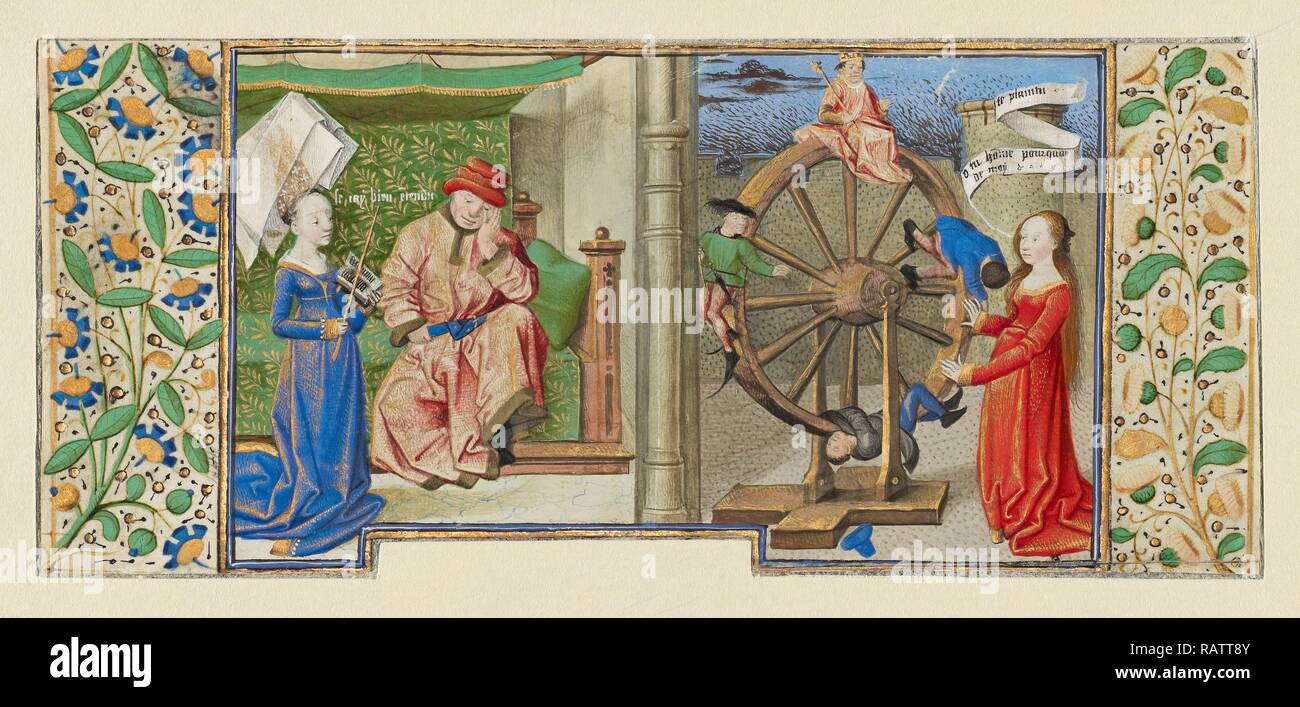 Philosophy Consoling Boethius and Fortune Turning the Wheel, Coëtivy Master (Henri de Vulcop?), French, active about reimagined Stock Photohttps://www.alamy.com/image-license-details/?v=1https://www.alamy.com/philosophy-consoling-boethius-and-fortune-turning-the-wheel-cotivy-master-henri-de-vulcop-french-active-about-reimagined-image230427259.html
Philosophy Consoling Boethius and Fortune Turning the Wheel, Coëtivy Master (Henri de Vulcop?), French, active about reimagined Stock Photohttps://www.alamy.com/image-license-details/?v=1https://www.alamy.com/philosophy-consoling-boethius-and-fortune-turning-the-wheel-cotivy-master-henri-de-vulcop-french-active-about-reimagined-image230427259.htmlRFRATT8Y–Philosophy Consoling Boethius and Fortune Turning the Wheel, Coëtivy Master (Henri de Vulcop?), French, active about reimagined
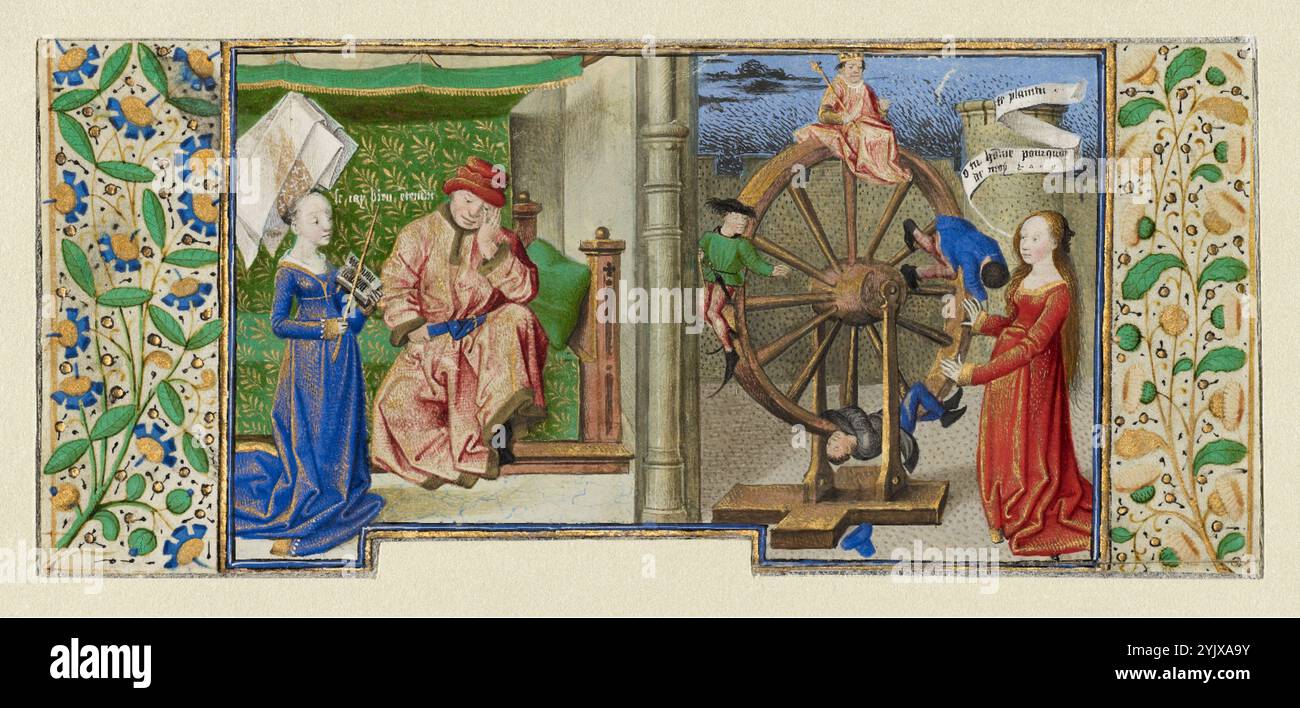 Miniatures from Boethius, Consolation de philosophie, about 1460-1470. Additional Info:After the Bible, the Consolation of Philosophy by the Roman philosopher and statesman Boethius was the most widely read book in the Middle Ages. Boethius wrote the work, a dialogue between its author and the personification of Philosophy, in prison while awaiting trial for treason. Discussing the problem of evil and the conflict between free will and divine providence, Philosophy explains the changeable nature of Fortune and consoles Boethius in his adversity. Stock Photohttps://www.alamy.com/image-license-details/?v=1https://www.alamy.com/miniatures-from-boethius-consolation-de-philosophie-about-1460-1470-additional-infoafter-the-bible-the-consolation-of-philosophy-by-the-roman-philosopher-and-statesman-boethius-was-the-most-widely-read-book-in-the-middle-ages-boethius-wrote-the-work-a-dialogue-between-its-author-and-the-personification-of-philosophy-in-prison-while-awaiting-trial-for-treason-discussing-the-problem-of-evil-and-the-conflict-between-free-will-and-divine-providence-philosophy-explains-the-changeable-nature-of-fortune-and-consoles-boethius-in-his-adversity-image631215927.html
Miniatures from Boethius, Consolation de philosophie, about 1460-1470. Additional Info:After the Bible, the Consolation of Philosophy by the Roman philosopher and statesman Boethius was the most widely read book in the Middle Ages. Boethius wrote the work, a dialogue between its author and the personification of Philosophy, in prison while awaiting trial for treason. Discussing the problem of evil and the conflict between free will and divine providence, Philosophy explains the changeable nature of Fortune and consoles Boethius in his adversity. Stock Photohttps://www.alamy.com/image-license-details/?v=1https://www.alamy.com/miniatures-from-boethius-consolation-de-philosophie-about-1460-1470-additional-infoafter-the-bible-the-consolation-of-philosophy-by-the-roman-philosopher-and-statesman-boethius-was-the-most-widely-read-book-in-the-middle-ages-boethius-wrote-the-work-a-dialogue-between-its-author-and-the-personification-of-philosophy-in-prison-while-awaiting-trial-for-treason-discussing-the-problem-of-evil-and-the-conflict-between-free-will-and-divine-providence-philosophy-explains-the-changeable-nature-of-fortune-and-consoles-boethius-in-his-adversity-image631215927.htmlRM2YJXA9Y–Miniatures from Boethius, Consolation de philosophie, about 1460-1470. Additional Info:After the Bible, the Consolation of Philosophy by the Roman philosopher and statesman Boethius was the most widely read book in the Middle Ages. Boethius wrote the work, a dialogue between its author and the personification of Philosophy, in prison while awaiting trial for treason. Discussing the problem of evil and the conflict between free will and divine providence, Philosophy explains the changeable nature of Fortune and consoles Boethius in his adversity.
 Boèce (Anicius Manlius Severinus Boethius, vers 480-524) Consolation de la philosophie, folio 40r 15e siècle Paris, Bibliothèque nationale de France credit:Photo12 Stock Photohttps://www.alamy.com/image-license-details/?v=1https://www.alamy.com/boce-anicius-manlius-severinus-boethius-vers-480-524-consolation-de-la-philosophie-folio-40r-15e-sicle-paris-bibliothque-nationale-de-france-creditphoto12-image612450466.html
Boèce (Anicius Manlius Severinus Boethius, vers 480-524) Consolation de la philosophie, folio 40r 15e siècle Paris, Bibliothèque nationale de France credit:Photo12 Stock Photohttps://www.alamy.com/image-license-details/?v=1https://www.alamy.com/boce-anicius-manlius-severinus-boethius-vers-480-524-consolation-de-la-philosophie-folio-40r-15e-sicle-paris-bibliothque-nationale-de-france-creditphoto12-image612450466.htmlRM2XGBEPX–Boèce (Anicius Manlius Severinus Boethius, vers 480-524) Consolation de la philosophie, folio 40r 15e siècle Paris, Bibliothèque nationale de France credit:Photo12
 Philosophy describes to Boethius the nature of fortune. A lady and a group of people oputside a castle. and decorated initial P. . Boethius the Consolation of Philosophy. (anonymous French translation), Le Livre de Boece de Consolacion (Book 2). France, Central (Bourges). Boethius's best known work is the Consolation of Philosophy (De consolatione philosophiae. 1477. Source: Harley 4336 f.1v. Language: Latin. Stock Photohttps://www.alamy.com/image-license-details/?v=1https://www.alamy.com/philosophy-describes-to-boethius-the-nature-of-fortune-a-lady-and-a-group-of-people-oputside-a-castle-and-decorated-initial-p-boethius-the-consolation-of-philosophy-anonymous-french-translation-le-livre-de-boece-de-consolacion-book-2-france-central-bourges-boethiuss-best-known-work-is-the-consolation-of-philosophy-de-consolatione-philosophiae-1477-source-harley-4336-f1v-language-latin-image226775016.html
Philosophy describes to Boethius the nature of fortune. A lady and a group of people oputside a castle. and decorated initial P. . Boethius the Consolation of Philosophy. (anonymous French translation), Le Livre de Boece de Consolacion (Book 2). France, Central (Bourges). Boethius's best known work is the Consolation of Philosophy (De consolatione philosophiae. 1477. Source: Harley 4336 f.1v. Language: Latin. Stock Photohttps://www.alamy.com/image-license-details/?v=1https://www.alamy.com/philosophy-describes-to-boethius-the-nature-of-fortune-a-lady-and-a-group-of-people-oputside-a-castle-and-decorated-initial-p-boethius-the-consolation-of-philosophy-anonymous-french-translation-le-livre-de-boece-de-consolacion-book-2-france-central-bourges-boethiuss-best-known-work-is-the-consolation-of-philosophy-de-consolatione-philosophiae-1477-source-harley-4336-f1v-language-latin-image226775016.htmlRMR4XDRM–Philosophy describes to Boethius the nature of fortune. A lady and a group of people oputside a castle. and decorated initial P. . Boethius the Consolation of Philosophy. (anonymous French translation), Le Livre de Boece de Consolacion (Book 2). France, Central (Bourges). Boethius's best known work is the Consolation of Philosophy (De consolatione philosophiae. 1477. Source: Harley 4336 f.1v. Language: Latin.
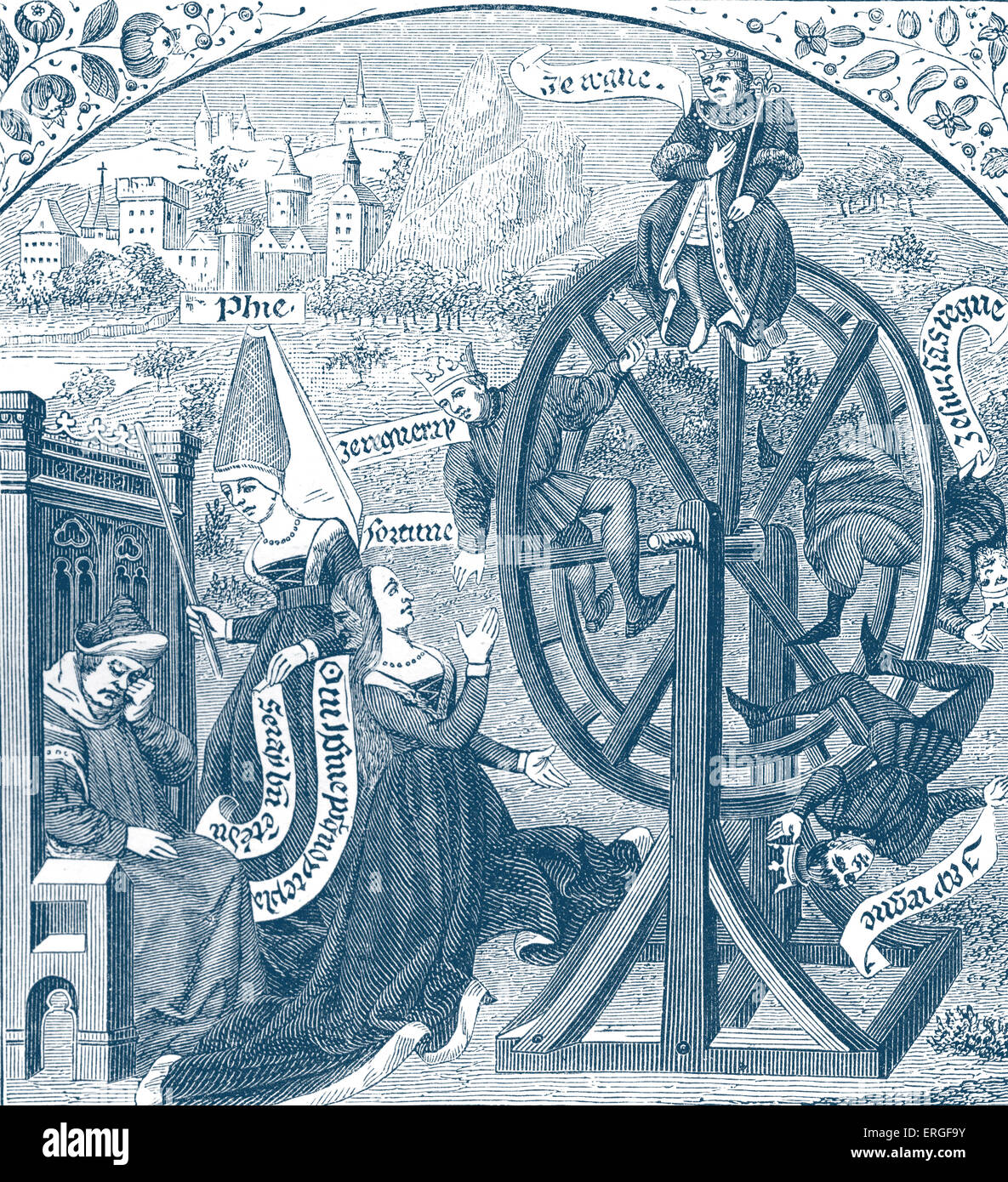 The Wheel of Fortune - from miniature of 'Consolation of Boethius', translated by Jean de Meung in 15th century manuscript Stock Photohttps://www.alamy.com/image-license-details/?v=1https://www.alamy.com/stock-photo-the-wheel-of-fortune-from-miniature-of-consolation-of-boethius-translated-83341831.html
The Wheel of Fortune - from miniature of 'Consolation of Boethius', translated by Jean de Meung in 15th century manuscript Stock Photohttps://www.alamy.com/image-license-details/?v=1https://www.alamy.com/stock-photo-the-wheel-of-fortune-from-miniature-of-consolation-of-boethius-translated-83341831.htmlRMERGF9Y–The Wheel of Fortune - from miniature of 'Consolation of Boethius', translated by Jean de Meung in 15th century manuscript
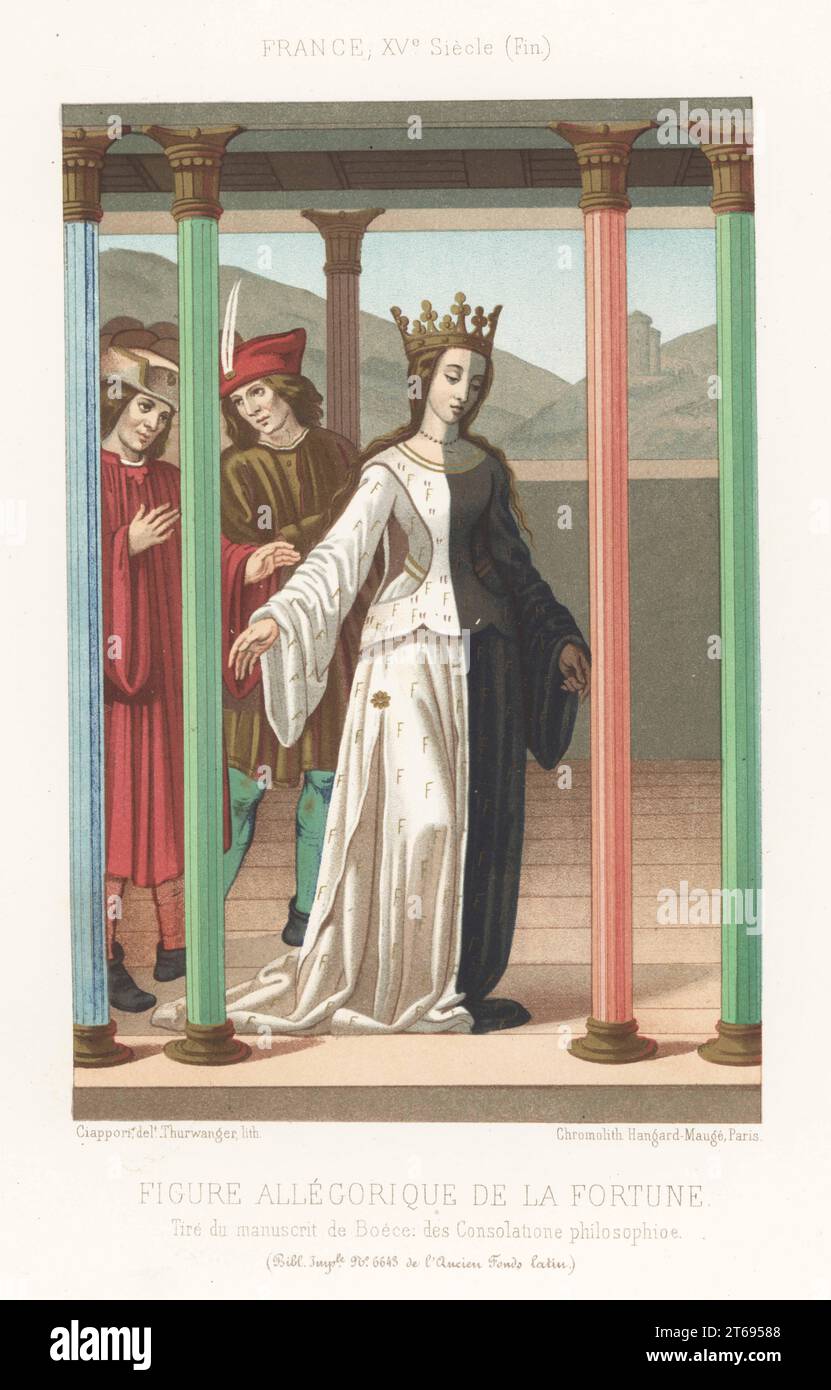 Fortune in crown walking in a colonnade, France, 15th century. In particolored robe, half white, half black, decorated with the letter F. France, end of the 15th century. Taken from a manuscript Boethius, De Consolatione philosophiae, MS 6643, Ancien Fonds Latin, Bibliotheque Imperiale. Figure allegorique de la Fortune. Chromolithograph by Thurwanger after an illustration by Claudius Joseph Ciappori from Charles Louandres Les Arts Somptuaires, The Sumptuary Arts, Hangard-Mauge, Paris, 1858. Stock Photohttps://www.alamy.com/image-license-details/?v=1https://www.alamy.com/fortune-in-crown-walking-in-a-colonnade-france-15th-century-in-particolored-robe-half-white-half-black-decorated-with-the-letter-f-france-end-of-the-15th-century-taken-from-a-manuscript-boethius-de-consolatione-philosophiae-ms-6643-ancien-fonds-latin-bibliotheque-imperiale-figure-allegorique-de-la-fortune-chromolithograph-by-thurwanger-after-an-illustration-by-claudius-joseph-ciappori-from-charles-louandres-les-arts-somptuaires-the-sumptuary-arts-hangard-mauge-paris-1858-image571831800.html
Fortune in crown walking in a colonnade, France, 15th century. In particolored robe, half white, half black, decorated with the letter F. France, end of the 15th century. Taken from a manuscript Boethius, De Consolatione philosophiae, MS 6643, Ancien Fonds Latin, Bibliotheque Imperiale. Figure allegorique de la Fortune. Chromolithograph by Thurwanger after an illustration by Claudius Joseph Ciappori from Charles Louandres Les Arts Somptuaires, The Sumptuary Arts, Hangard-Mauge, Paris, 1858. Stock Photohttps://www.alamy.com/image-license-details/?v=1https://www.alamy.com/fortune-in-crown-walking-in-a-colonnade-france-15th-century-in-particolored-robe-half-white-half-black-decorated-with-the-letter-f-france-end-of-the-15th-century-taken-from-a-manuscript-boethius-de-consolatione-philosophiae-ms-6643-ancien-fonds-latin-bibliotheque-imperiale-figure-allegorique-de-la-fortune-chromolithograph-by-thurwanger-after-an-illustration-by-claudius-joseph-ciappori-from-charles-louandres-les-arts-somptuaires-the-sumptuary-arts-hangard-mauge-paris-1858-image571831800.htmlRM2T69588–Fortune in crown walking in a colonnade, France, 15th century. In particolored robe, half white, half black, decorated with the letter F. France, end of the 15th century. Taken from a manuscript Boethius, De Consolatione philosophiae, MS 6643, Ancien Fonds Latin, Bibliotheque Imperiale. Figure allegorique de la Fortune. Chromolithograph by Thurwanger after an illustration by Claudius Joseph Ciappori from Charles Louandres Les Arts Somptuaires, The Sumptuary Arts, Hangard-Mauge, Paris, 1858.
 Philosophy Consoling Boethius and Fortune Turning the Wheel, Coëtivy Master (Henri de Vulcop?) (French, active about reimagined Stock Photohttps://www.alamy.com/image-license-details/?v=1https://www.alamy.com/philosophy-consoling-boethius-and-fortune-turning-the-wheel-cotivy-master-henri-de-vulcop-french-active-about-reimagined-image230225600.html
Philosophy Consoling Boethius and Fortune Turning the Wheel, Coëtivy Master (Henri de Vulcop?) (French, active about reimagined Stock Photohttps://www.alamy.com/image-license-details/?v=1https://www.alamy.com/philosophy-consoling-boethius-and-fortune-turning-the-wheel-cotivy-master-henri-de-vulcop-french-active-about-reimagined-image230225600.htmlRFRAFK2T–Philosophy Consoling Boethius and Fortune Turning the Wheel, Coëtivy Master (Henri de Vulcop?) (French, active about reimagined
 Philosophy Consoling Boethius and Fortune Turning the Wheel, about 1460-1470. Additional Info:At the left, Philosophy, personified as a fashionably dressed young woman, visits Boethius, who had lost his exalted position as Roman envoy. She asks him why he is despondent, saying, "you are wrong if you think that Fortune has changed towards you. Change is her normal behavior." On the right, Fortune, a beautiful woman, spins her wheel, which represents the changes she brings about in men's lives. A king sits on top of the wheel, but a simple turn of the wheel can bring him down in stati Stock Photohttps://www.alamy.com/image-license-details/?v=1https://www.alamy.com/philosophy-consoling-boethius-and-fortune-turning-the-wheel-about-1460-1470-additional-infoat-the-left-philosophy-personified-as-a-fashionably-dressed-young-woman-visits-boethius-who-had-lost-his-exalted-position-as-roman-envoy-she-asks-him-why-he-is-despondent-saying-quotyou-are-wrong-if-you-think-that-fortune-has-changed-towards-you-change-is-her-normal-behaviorquot-on-the-right-fortune-a-beautiful-woman-spins-her-wheel-which-represents-the-changes-she-brings-about-in-mens-lives-a-king-sits-on-top-of-the-wheel-but-a-simple-turn-of-the-wheel-can-bring-him-down-in-stati-image631215914.html
Philosophy Consoling Boethius and Fortune Turning the Wheel, about 1460-1470. Additional Info:At the left, Philosophy, personified as a fashionably dressed young woman, visits Boethius, who had lost his exalted position as Roman envoy. She asks him why he is despondent, saying, "you are wrong if you think that Fortune has changed towards you. Change is her normal behavior." On the right, Fortune, a beautiful woman, spins her wheel, which represents the changes she brings about in men's lives. A king sits on top of the wheel, but a simple turn of the wheel can bring him down in stati Stock Photohttps://www.alamy.com/image-license-details/?v=1https://www.alamy.com/philosophy-consoling-boethius-and-fortune-turning-the-wheel-about-1460-1470-additional-infoat-the-left-philosophy-personified-as-a-fashionably-dressed-young-woman-visits-boethius-who-had-lost-his-exalted-position-as-roman-envoy-she-asks-him-why-he-is-despondent-saying-quotyou-are-wrong-if-you-think-that-fortune-has-changed-towards-you-change-is-her-normal-behaviorquot-on-the-right-fortune-a-beautiful-woman-spins-her-wheel-which-represents-the-changes-she-brings-about-in-mens-lives-a-king-sits-on-top-of-the-wheel-but-a-simple-turn-of-the-wheel-can-bring-him-down-in-stati-image631215914.htmlRM2YJXA9E–Philosophy Consoling Boethius and Fortune Turning the Wheel, about 1460-1470. Additional Info:At the left, Philosophy, personified as a fashionably dressed young woman, visits Boethius, who had lost his exalted position as Roman envoy. She asks him why he is despondent, saying, "you are wrong if you think that Fortune has changed towards you. Change is her normal behavior." On the right, Fortune, a beautiful woman, spins her wheel, which represents the changes she brings about in men's lives. A king sits on top of the wheel, but a simple turn of the wheel can bring him down in stati
 Philosophy Consoling Boethius and Fortune Turning the Wheel, Coëtivy Master (Henri de Vulcop?) (French, active about 1450 - 1485), Paris, France, about 1460 - 1470, Tempera colors, gold leaf, and gold paint on parchment, Leaf: 7.3 x 17 cm (2 7,8 x 6 11,16 in, Reimagined by Gibon, design of warm cheerful glowing of brightness and light rays radiance. Classic art reinvented with a modern twist. Photography inspired by futurism, embracing dynamic energy of modern technology, movement, speed and revolutionize culture. Stock Photohttps://www.alamy.com/image-license-details/?v=1https://www.alamy.com/philosophy-consoling-boethius-and-fortune-turning-the-wheel-cotivy-master-henri-de-vulcop-french-active-about-1450-1485-paris-france-about-1460-1470-tempera-colors-gold-leaf-and-gold-paint-on-parchment-leaf-73-x-17-cm-2-78-x-6-1116-in-reimagined-by-gibon-design-of-warm-cheerful-glowing-of-brightness-and-light-rays-radiance-classic-art-reinvented-with-a-modern-twist-photography-inspired-by-futurism-embracing-dynamic-energy-of-modern-technology-movement-speed-and-revolutionize-culture-image350062025.html
Philosophy Consoling Boethius and Fortune Turning the Wheel, Coëtivy Master (Henri de Vulcop?) (French, active about 1450 - 1485), Paris, France, about 1460 - 1470, Tempera colors, gold leaf, and gold paint on parchment, Leaf: 7.3 x 17 cm (2 7,8 x 6 11,16 in, Reimagined by Gibon, design of warm cheerful glowing of brightness and light rays radiance. Classic art reinvented with a modern twist. Photography inspired by futurism, embracing dynamic energy of modern technology, movement, speed and revolutionize culture. Stock Photohttps://www.alamy.com/image-license-details/?v=1https://www.alamy.com/philosophy-consoling-boethius-and-fortune-turning-the-wheel-cotivy-master-henri-de-vulcop-french-active-about-1450-1485-paris-france-about-1460-1470-tempera-colors-gold-leaf-and-gold-paint-on-parchment-leaf-73-x-17-cm-2-78-x-6-1116-in-reimagined-by-gibon-design-of-warm-cheerful-glowing-of-brightness-and-light-rays-radiance-classic-art-reinvented-with-a-modern-twist-photography-inspired-by-futurism-embracing-dynamic-energy-of-modern-technology-movement-speed-and-revolutionize-culture-image350062025.htmlRF2B9EKK5–Philosophy Consoling Boethius and Fortune Turning the Wheel, Coëtivy Master (Henri de Vulcop?) (French, active about 1450 - 1485), Paris, France, about 1460 - 1470, Tempera colors, gold leaf, and gold paint on parchment, Leaf: 7.3 x 17 cm (2 7,8 x 6 11,16 in, Reimagined by Gibon, design of warm cheerful glowing of brightness and light rays radiance. Classic art reinvented with a modern twist. Photography inspired by futurism, embracing dynamic energy of modern technology, movement, speed and revolutionize culture.